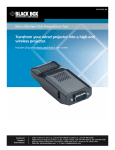Download AirLive AirVideo-100 Manual - Airlivecam.eu | Kamery Airlive
Transcript
Table of Contents AirVideo-100 W ireless Presenter Dongle User’s Manual AirVideo-100 User’s Manual Copyright & Declaimer Copyright & Disclaimer No part of this publication may be reproduced in any form or by any means, whether electronic, mechanical, photocopying, or recording without the written consent of OvisLink Corp. OvisLink Corp. has made the best effort to ensure the accuracy of the information in this user’s guide. However, we are not liable for the inaccuracies or errors in this guide. Please use with caution. All information is subject to change without notice All Trademarks are properties of their respective holders. AirVideo-100 User’s Manual 2 Copyright & Disclaimer Federal Communication Commission Interference Statement This equipment has been tested and found to comply with the limits for a Class B digital device, pursuant to Part 15 of FCC Rules. These limits are designed to provide reasonable protection against harmful interference in a residential installation. This equipment generates, uses, and can radiate radio frequency energy and, if not installed and used in accordance with the instructions, may cause harmful interference to radio communications. However, there is no guarantee that interference will not occur in a particular installation. If this equipment does cause harmful interference to radio or television reception, which can be determined by turning the equipment off and on, the user is encouraged to try to correct the interference by one or more of the following measures: 1. Reorient or relocate the receiving antenna. 2. Increase the separation between the equipment and receiver. 3. Connect the equipment into an outlet on a circuit different from that to which the receiver is connected. 4. Consult the dealer or an experienced radio technician for help. FCC Caution This device and its antenna must not be co-located or operating in conjunction with any other antenna or transmitter. This device complies with Part 15 of the FCC Rules. Operation is subject to the following two conditions: (1) this device may not cause harmful interference, and (2) this device must accept any interference received, including interference that may cause undesired operation. Any changes or modifications not expressly approved by the party responsible for compliance could void the authority to operate equipment. 3 AirVideo-100 User’s Manual Copyright & Declaimer Federal Communication Commission (FCC) Radiation Exposure Statement This EUT is compliance with SAR for general population/uncontrolled exposure limits in ANSI/IEEE C95.1-1999 and had been tested in accordance with the measurement methods and procedures specified in OET Bulletin 65 Supplement C. R&TTE Compliance Statement This equipment complies with all the requirements of DIRECTIVE 1999/5/EC OF THE EUROPEAN PARLIAMENT AND THE COUNCIL of March 9, 1999 on radio equipment and telecommunication terminal Equipment and the mutual recognition of their conformity (R&TTE) The R&TTE Directive repeals and replaces in the directive 98/13/EEC (Telecommunications Terminal Equipment and Satellite Earth Station Equipment) As of April 8, 2000. Safety This equipment is designed with the utmost care for the safety of those who install and use it. However, special attention must be paid to the dangers of electric shock and static electricity when working with electrical equipment. All guidelines of this and of the computer manufacture must therefore be allowed at all times to ensure the safe use of the equipment. EU Countries Intended for Use The ETSI version of this device is intended for home and office use in Austria, Belgium, Denmark, Finland, France, Germany, Greece, Ireland, Italy, Luxembourg, the Netherlands, Portugal, Spain, Sweden, and the United Kingdom. The ETSI version of this device is also authorized for use in EFTA member states: Iceland, Liechtenstein, Norway, and Switzerland. EU Countries Not intended for use None. The specification is subject to change without notice. AirVideo-100 User’s Manual 4 Table of Contents Table of Contents 1. Introduction ........................................................................................................7 1.1. System Requirements ........................................................................... 8 1.2. Package Contents................................................................................. 8 1.3. Hardware Installation ............................................................................ 9 2. 3. Software Installation.........................................................................................11 Windows WPS Utility........................................................................................16 3.1 Login ................................................................................................... 17 3.2 Main User Interface............................................................................. 18 3.3 Screen Projection................................................................................ 19 3.4 Menu Description ................................................................................ 20 3.5 Show Login Code................................................................................ 20 3.6 Open Admin Web Page....................................................................... 21 3.7 Searching Server ................................................................................ 22 3.8 Projection Quality ................................................................................ 23 3.9 Projection Source................................................................................ 24 3.10 Connection Profile............................................................................... 25 3.11 Auto WiFi Connect .............................................................................. 26 3.12 Auto Power Manager .......................................................................... 27 3.13 Hide UI ................................................................................................ 27 3.14 Advanced Screen Capture .................................................................. 28 3.15 Make PnS Token ................................................................................. 29 3.16 Copy Application to desktop ................................................................ 30 3.17 About................................................................................................... 31 3.18 Exit ...................................................................................................... 32 4. Mac WPS Utility ................................................................................................33 4.1 Launch Application .............................................................................. 33 4.2 Main User Interface............................................................................. 35 4.3 Screen Projection................................................................................ 35 5. Web Management .............................................................................................37 5.1 Home Page ......................................................................................... 37 5.2 Download Software ............................................................................. 38 5.3 Login Web Admin ................................................................................ 39 5.3.1 System Status .............................................................................. 40 5.3.2 Network Setup ............................................................................. 41 5.3.3 Projection Setup........................................................................... 43 AirVideo-100 User’s Manual Table of Contents 5.3.4 5.3.5 5.3.6 5.3.7 5.3.8 6. 7. Change Passwords ...................................................................... 44 Reset to Default ........................................................................... 45 Firmware Upgrade ....................................................................... 46 Reboot System ............................................................................ 47 Logout .......................................................................................... 48 Specifications ...................................................................................................49 Wireless Network Glossary .............................................................................50 AirVideo-100 User’s Manual 6 1. Introduction 1 1. Introduction Thank you for purchasing AirLive AirVideo-100, the Wireless Presenter Dongle. The Wireless Presenter Dongle is the most cost-effective and efficient way to upgrade your projector by simply plug-in AirVideo-100. The simple step of Plug-and-Connect allows anyone to give a wireless presentation instantly. The AirVideo-100 is a musthave device for your meeting room. y The smallest wireless presentation system with slim and compact design y Upgrade your projector instantly with Wi-Fi capability y Display presentation materials wirelessly without boundary y 4-to-1 split screen projection; up to 4 computers simultaneously y Power over VGA, power directly supplied from the VGA port* *The projector itself must also support Power over VGA to enable this function, please refer to the session of “Specifications” for compatible list 7 AirVideo-100 User’s Manual 1. Introduction 1.1. System Requirements y Projector/Monitor or TV with VGA input y Client utility: Windows XP/Vista/7 and Mac OS X 10.5/10.6 1.2. Package Contents Before installing the adapter, please check if there’s anything missing in the package, and contact your dealer of purchase to claim for missing items: y AirVideo-100 y Quick Setup Guide y Software CD y 6V DC 0.8A power adapter AirVideo-100 User’s Manual 8 1. Introduction 1.3. Hardware Installation y VGA 15-pin Male Connector y Power jack y Link/Activity LED (Green) y Reset button Mode LED Status Power ON Steady Green LED Off Adapter disabled/No Power 9 AirVideo-100 User’s Manual 1. Introduction Quick Start Plug the AirVideo-100 into projector’s VGA input or connect it to a VGA cable and turn on the projector power Power on AirVideo-100, when projector shows the default menu on the screen as illustrate below, the device is now ready. AirVideo-100 User’s Manual 10 2. Software Installation 2 2. Software Installation 1. Make sure your MAC/PC WLAN is enabled then connect to AirVideo-100 via the SSID of “AirLive” 2. Open your browser and enter the IP address to access the AirVideo-100 home page. y The default IP address of AirVideo-100 is 192.168.1.1 or refers to the IP address shown on the bottom left corner of projector screen. 11 AirVideo-100 User’s Manual 2. Software Installation 3. Download the client software, select “Windows 7/ Vista / XP / 2000” and execute the installation program. y After installing the program, you will see the AirLive WPS shortcut on the computer screen. AirVideo-100 User’s Manual 12 2. Software Installation 4. If you are using Internet Explorer 8 (IE8) or above to download the utility, please disable the “SmartScreen Filter,” otherwise the utility download might stop at 99% 13 AirVideo-100 User’s Manual 2. Software Installation 5. Make sure your personal firewall allows AirLive WPS software to pass through. 6. Enter the LOGIN CODE y You can see the login code is the top left of the projector screen. 7. Click the “Play” button to start your projection AirVideo-100 User’s Manual 14 2. Software Installation 8. There is another way to install AirLive WPS utility. Please insert the enclosed software CD into the CD-ROM drive and click “Install Driver & Utility” from the autorun screen and click the “setup.exe” under the folder “Windows.” If the autorun screen did not appear, run the “autorun.exe” from the CD drive and then follow the on-screen instruction to complete the software installation. 9. Mac utility can only be installed from the software CD. Please insert the enclosed software CD into the CD-ROM drive and click “Browse CD” from the autorun screen and copy the Mac utility file under the folder of “Mac_utility.” Please copy the MAC utility to your Mac OS X and proceed with the installation. 15 AirVideo-100 User’s Manual 3. Windows WPS Utility 3 3. Windows WPS Utility The WPS (Wireless Presentation System) utility is a powerful application that helps you scan and connect to your AirVideo-100 easily. After you download the AirLive WPS utility successfully from either the AirVideo-100 web page or the software CD, then follow the steps below to begin. 1. Click AirVideo-100 icon to execute the program. 2. Program will start to search for AirVideo-100 automatically. (Please make sure your WLAN is enabled.) 3. If AirVideo-100 is found the “Login Code” dialog box will pop up on your computer screen. z Searching for AirVideo-100 z When AirVideo-100 is found, enter login code to start. AirVideo-100 User’s Manual 16 3. Windows WPS Utility 3.1 Login 1. After “Login Code” dialog box shown, enter login code to start presentation. 2. You can see the login code shown in the top left of the projector screen. 17 AirVideo-100 User’s Manual 3. Windows WPS Utility 3.2 Main User Interface Login Coded Menu Area Status Indicator Control Area for Screen Projection Feature AirVideo-100 User’s Manual 18 3. Windows WPS Utility 3.3 Screen Projection Click the “Play” button for full or split screen, you can project the main screen on to the display immediately, click the “Pause” button, to freeze the image, and click the “Stop” button to end the presentation. Button Description Full Screen projection Project to Split #1 Project to Split #2 Project to Split #3 Project to Split #4 Stop projecting Pause projecting 19 AirVideo-100 User’s Manual 3. Windows WPS Utility 3.4 Menu Description Login Code Menu Exit Minimize 3.5 Show Login Code Click “Show Login Code” to display the login code on the top right of the desktop and it will close automatically after 10 seconds. You can also click on the area to close this window manually. AirVideo-100 User’s Manual 20 3. Windows WPS Utility 3.6 Click Open Admin Web Page to open the function menu and select “Web Admin” management web page. The detailed functions of the web page will be described in the next chapter. 21 AirVideo-100 User’s Manual 3. Windows WPS Utility 3.7 Searching Server Click “Search Server” to search for the WPS-Dongle again. AirVideo-100 User’s Manual 22 3. Windows WPS Utility 3.8 Projection Quality Click the “Projection Quality”; choose “Normal” for faster projection speed with lower screen image quality, and “Best” for better image quality but slower projection speed. 23 AirVideo-100 User’s Manual 3. Windows WPS Utility 3.9 Projection Source Click “Projection Source” to project the main screen of the desktop or the virtual extended screen. Note: This function is only supported by Windows XP and a virtual display driver must first be installed. AirVideo-100 User’s Manual 24 3. Windows WPS Utility 3.10 Connection Profile Click “Connection Profile”, then click “save current as” to save current connection configuration into Profile, or click the “Manage Profile” to add, delete or modify current profiles. z Save Current as Click “Save current as”, to save your current connection as a profile for future quick-connect. 25 AirVideo-100 User’s Manual 3. Windows WPS Utility z Manage Profile Click “Manage Profile” to view current profile, add or delete the profile, and edit the existing profile. 3.11 Auto WiFi Connect Click “Auto WiFi Connect” to enable the AWZC function, this function can save the WiFi connection steps. AirVideo-100 User’s Manual 26 3. Windows WPS Utility 3.12 Auto Power Manager For best projection performance the auto power manager application will switch the computer’s current power setting to “highest performance”. Click the “Auto Power Manager” to enable or disable this function. 3.13 Hide UI Click the “Hide UI” to hide or display the application control panel. 27 AirVideo-100 User’s Manual 3. Windows WPS Utility 3.14 Advanced Screen Capture Click “Advanced Screen Capture” to see tip windows and other layered windows (including the main UI) on the connected display. The mouse cursor may blink from time to time when you are projecting your computer screen. z Disable “Advanced Screen Capture” Tip windows is not shown in projector z Enable “Advanced Screen Capture” AirVideo-100 User’s Manual 28 3. Windows WPS Utility Tip windows is shown in projector 3.15 Make PnS Token Click “Make PnS Token” to make a USB Token, you can insert a USB thumb drive and follow the wizard instructions to make the Token. This Token’s purpose is for the guests during his/her visit; he/she does not need to install the utility into his/her computer for wireless presentation. 29 AirVideo-100 User’s Manual 3. Windows WPS Utility 3.16 Copy Application to desktop Click “Copy Application to desktop” to copy the application to your desktop immediately even if you don’t have the system privilege. AirVideo-100 User’s Manual 30 3. Windows WPS Utility 3.17 About Click “About” to show system information, it contains Client version, IP address and other information. 31 AirVideo-100 User’s Manual 3. Windows WPS Utility 3.18 Exit Click “Exit” to exit this application. It will stop current session and close the application immediately. AirVideo-100 User’s Manual 32 4. Mac WPS Utility 4 4.1 4. Mac WPS Utility Launch Application 1. Enable your WLAN and connect to AirVideo-100, default SSID: AirLive 2. Execute WPS client software for Mac from the enclosed software CD 33 AirVideo-100 User’s Manual 4. Mac WPS Utility 3. Launch WPS software and enter the login code 4. Start Projection AirVideo-100 User’s Manual 34 4. Mac WPS Utility 4.2 Main User Interface Login Code Menu Area Status Indicator Control Area for Screen Projection Feature 4.3 Screen Projection Click the “Play” button for full or split screen, you can project the main screen on to the display immediately, click the “Pause” button, you can freeze you projection screen, and click the “Stop” button to stop projecting your screen. 35 AirVideo-100 User’s Manual 4. Mac WPS Utility Button Description Full Screen projection Project to Split #1 Project to Split #2 Project to Split #3 Project to Split #4 Stop projecting Pause projecting AirVideo-100 User’s Manual 36 5. Web Management 5 5.1 5. Web Management Home Page 1. Make sure your computer connects to AirVideo-100 successfully by Wi-Fi. 2. Enter your IP address on the browser; you can see the IP on the projector screen. The default IP is 192.168.1.1 37 AirVideo-100 User’s Manual 5. Web Management 5.2 Download Software 1. Select “Download software” function. 2. Please select the “Windows 7/Vista / XP / 2000” and execute the installation program. 3. Follow Installation Wizard instructions to proceed till the installation process complete. 4. If pop up “Windows Security Alert” because Windows firewall block this program. Select press “Unblock” button to continue the installation. 5. Once installation complete, a utility shortcut come out on the screen. AirVideo-100 User’s Manual 38 5. Web Management 5.3 Login Web Admin 1. Click [Admin] and then enter password to login web page. 2. The password default value is “admin” 39 AirVideo-100 User’s Manual 5. Web Management 5.3.1 System Status Click [System Status], shows current system status. Model Name: Product model name. Versions: 1. Firmware version no.: Product firmware version number. Network Status: 1. IP address: IP address of WPS-Dongle device. 2. Subnet Mask: subnet mask 3. Default Gateway: default gateway 4. Wireless MAC address: wireless MAC address AirVideo-100 User’s Manual 40 5. Web Management Connection Status: 1. Projecting status: which is “Waiting for projecting” or “Projecting” 2. Total Users: It shows how many users login into AirVideo-100. 5.3.2 Network Setup There are many kinds of operating configurations as below. 41 AirVideo-100 User’s Manual 5. Web Management < Wireless Setup> < Auto-Configuration Network Setup> The default setting of the WPS box is DHCP client. When the WPS box is connected to a LAN that already has a DHCP server present, the WPS box takes an IP address assigned to it by the server. When the WPS box is connected to a LAN that does not have a DHCP server, the WPS box becomes the DHCP server in the network. < IP Setup> You can select “obtain IP address automatically” or “Use the following IP address” y y y y IP Address: The default value is 192.168.1.1 Subnet Mask: The default value is 255.255.255.0 Default Gateway: The default value is 192.168.1.1 DNS Server: The default value is 192.168.1.1 <DHCP Server Setup> You can select “auto (Enable/Disable DHCP Server” or “Disable”) y y y y y Start IP: The start IP address of DHCP Server. End IP: The end IP address of DHCP Server Subnet Mask: The default value is 255.255.255.0 Default Gateway: The default value is 192.168.1.1 DNS Server: The default value is 192.168.1.1 AirVideo-100 User’s Manual 42 5. Web Management < Wireless Setup> y y y y y y Region: default value is “Worldwide” SSID: SSID string, max. Length is 32 bytes SSID Broadcast: The default value is “Enable” Channel: to set fixed channel or Auto. The “Auto” means after power on WPS, it will scan all of wireless channel and select clear one channel automatically Encryption: you can select “Disable” or one of WEP/WPA/WPA2 64bit or 128bit in ASCII or HEX string Key: If Encryption is enabled, you have to set key value according to the encryption mode you selected. <Apply >: press button to confirm changes <Cancel>: press button to abort action <Logout>: Back to main menu 5.3.3 Projection Setup 43 AirVideo-100 User’s Manual 5. Web Management Click [Projection Setup] button y <Resolution>: XGA (1024x768) and SVGA (800x600). The default value is “XGA”. y y <Login Code>: You can select “Disable”, “Random”, or “Use the following code” to set a specified 4-characters Number. <Apply>:Confirm and Save modifications. y <Cancel>: Cancel all the modifications. 5.3.4 Change Passwords Click [Change Password] button, to change password value. The length of password is up to 8 characters. y y y <Enter New Password>: enter new password you want to change for each category. <Confirm New Password>: confirm new password. <Apply>: Confirmation and Save modifications. AirVideo-100 User’s Manual 44 5. Web Management 5.3.5 Reset to Default Click [Reset to Default] button to restore factory default settings. <Apply>: Confirmation and action. *** Another way to restore Factory Default Settings, Follow below procedures. 1. Press [Reset] button and Hold. 2. Turn on WPS-Dongle. 3. Wait for over 10 seconds and release [Reset] button. 4. It will take effect to restore factory default settings. Power LED Reset to default Power Jack button 45 AirVideo-100 User’s Manual 5. Web Management 5.3.6 Firmware Upgrade Click [Firmware Upgrade] button to upgrade firmware 1. First, download latest firmware 2. 3. 4. 5. 6. Click <Browse> to select file you want to upgrade Click <Upgrade> to start A warning message and countdown timer will appear on screen After a few minutes, a “complete” message will appear on screen. Restart WPS-Dongle to allow upgrade to take effect AirVideo-100 User’s Manual 46 5. Web Management 5.3.7 Reboot System Click [Reboot System] button, to restart system y <Reboot>: reboot system automatically 47 AirVideo-100 User’s Manual 5. Web Management 5.3.8 Logout Click [Logout] button, to leave the control system AirVideo-100 User’s Manual 48 6. Specifications 6 6. Specifications Standard IEEE 802.11b/g 2.4GHz Wireless Channel 11(US, Canada); 13(Europe) Data Rate Up to 54Mbps IP Configuration DHCP/Fixed IP Management Web UI Configuration Security IEEE Standard 64/128bit, WEP/WPA/WPA2 Internal Printed Antenna Antenna Receiving Sensitivity Support Computer Resolution Support Output Resolution Support Operating System Mechanical Power -65dBm@54Mbps -80dBm@11Mbps SVGA (800x600) / XGA (1024x768) / SXGA (1280x1024) WXGA (1280x768) / WSXGA (1440x900, 1600x1024) / UXGA (1600x1200) WUXGA (1920x1200) / QXGA (2048x1536) / Others SVGA (800x600) / XGA (1024x768) Windows XP/Vista/7, 32/64-bit Mac OS X 10.5/10.6 Dimension: 85*38.2*24 mm Weight: 53g PoVGA compliant 6V DC 0.8A, 100~240V 49 AirVideo-100 User’s Manual 7. Wireless Network Glossary 7 7. Wireless Network Glossary The wireless network glossary contains explanation or information about common terms used in wireless networking products. Some of information in this glossary might be outdated, please use with caution. 802.11a An IEEE specification for wireless networking that operates in the 5 GHz frequency range (5.15 GHz to 5.850 GHz) with a maximum of 54Mbps data transfer rate. The 5GHz frequency band is not as crowded as the 2.4GHz band. In addition, the 802.11a have 12 non-overlapping channels, comparing to 802.11b/g's 3 non-overlapping channels. This means the possibility to build larger non-interfering networks. However, the 802.11a deliver shorter distance at the same output power when comparing to 802.11g. 802.11b International standard for wireless networking that operates in the 2.4GHz frequency band (2.4 GHz to 2.4835 GHz) and provides a throughput up to 11 Mbps. 802.11d Also known as “Global Roaming”. 802.11d is a standard for use in countries where systems using other standards in the 802.11 family are not allowed to operate. 802.11e The IEEE QoS standard for prioritizing traffic of the VoIP and multimedia applications. The WMM is based on a subset of the 802.11e. AirVideo-100 User’s Manual 50 7. Wireless Network Glossary 802.11g A standard provides a throughput up to 54 Mbps using OFDM technology. It also operates in the 2.4GHz frequency band as 802.11b. 802.11g devices are backward compatible with 802.11b devices. 802.11h This IEEE standard define the TPC (transmission power control) and DFS (dynamic frequency selection) required to operate WiFi devices in 5GHz for EU. 802.11i The IEEE standard for wireless security, 802.11i standard includes TKIP, CCMP, and AES encryption to improve wireless security. It is also know as WPA2. 802.11n 802.11n is a recent amendment which improves upon the previous 802.11 standards by adding multiple-input multiple-output (MIMO) and many other newer features. The IEEE has approved the amendment and it was published in October 2009. Enterprises, however, have already begun migrating to 802.11n networks based on the Wi-Fi Alliance's certification of products conforming to a 2007 draft of the 802.11n proposal. 802.11n provides a throughput up to 300Mbps using OFDM technology. 802.3ad 802.3ad is an IEEE standard for bonding or aggregating multiple Ethernet ports into one virtual port (also known as trunking) to increase the bandwidth. 802.3af This is the PoE (Power over Ethernet) standard by IEEE committee. 803.af uses 48V POE standard that can deliver up to 100 meter distance over Ethernet cable. 51 AirVideo-100 User’s Manual 7. Wireless Network Glossary 802.1d STP Spanning Tree Protocol. It is an algorithm to prevent network from forming. The STP protocol allows net work to provide a redundant link in the event of a link failure. It is advise to turn on this option for multi-link bridge network. 802.1Q Tag VLAN In 802.1Q VLAN, the VLAN information is written into the Ethernet packet itself. Each packet carries a VLAN ID (called Tag) as it traveled across the network. Therefore, the VLAN configuration can be configured across multiple switches. In 802.1Q spec, possible 4096 VLAN ID can be created. Although for some devices, they can only view in frames of 256 ID at a time. 802.1x 802.1x is a security standard for wired and wireless LANs. In the 802.1x parlance, there are usually supplicants (client), authenticator (switch or AP), and authentication server (radius server) in the network. When a supplicants request a service, the authenticator will pass the request and wait for the authentication server to grant access and register accounting. The 802.1x is the most widely used method of authentication by WISP. Ad-hoc A Peer-to-Peer wireless network. An Ad-hoc wireless network do not use wireless AP or router as the central hub of the network. Instead, wireless client are connected directly to each other. The disadvantage of Adhoc network is the lack of wired interface to Internet connections. It is not recommended for network more than 2 nodes. AirVideo-100 User’s Manual 52 7. Wireless Network Glossary Access Point (AP) The central hub of a wireless LAN network. Access Points have one or more Ethernet ports that can connect devices (such as Internet connection) for sharing. Multi-function Access Point can also function as an Ethernet client, wireless bridge, or repeat signals from other AP. Access Points typically have more wireless functions comparing to wireless routers. ACK Timeout Acknowledgement Timeout Windows. When a packet is sent out from one wireless station to the other, it will waits for an Acknowledgement frame from the remote station. The station will only wait for a certain amount of time; this time is called the ACK timeout. If the ACK is NOT received within that timeout period then the packet will be re-transmitted resulting in reduced throughput. If the ACK setting is too high then throughput will be lost due to waiting for the ACK Window to timeout on lost packets. If the ACK setting is too low then the ACK window will have expired and the returning packet will be dropped, greatly lowering throughput. By having the ability to adjust the ACK setting we can effectively optimize the throughput over long distance links. This is especially true for 802.11a and 802.11g networks. Setting the correct ACK timeout value needs to consider 3 factors: distance, AP response time, and interference. Bandwidth Management Bandwidth Management controls the transmission speed of a port, user, IP address, and application. Router can use bandwidth control to limit the Internet connection speed of individual IP or Application. It can also guarantee the speed of certain special application or privileged IP address - a crucial feature of QoS (Quality of Service) function. Bootloader Bootloader is the under layering program that will start at the power-up before the device loads firmware. It is similar to BIOS on a personal computer. When a firmware crashed, you might be able to recover your device from bootloader. 53 AirVideo-100 User’s Manual 7. Wireless Network Glossary Bridge A product that connects 2 different networks that uses the same protocol. Wireless bridges are commonly used to link network across remote buildings. For wireless application, there are 2 types of Bridges. WDS Bridge can be used in Point-to-Point or Point-to-Multipoint topology. Bridge Infrastructure works with AP mode to form a star topology. Cable and Connector Loss During wireless design and deployment, it is important to factor in the cable and connector loss. Cable and connector loss will reduce the output power and receiver sensitivity of the radio at connector end. The longer the cable length is, the more the cable loss. Cable loss should be subtracted from the total output power during distance calculation. For example, if the cable and connector loss is 3dBm and the output power is 20dBm; the output power at the cable end is only 17dBm. Client Client means a network device or utility that receives service from host or server. A client device means end user device such as wireless cards or wireless CPE. CPE Devices CPE stands for Customer Premises Equipment. A CPE is a device installed on the end user's side to receive network services. For example, on an ADSL network, the ADSL modem/router on the subscriber's home is the CPE device. Wireless CPE means a complete Wireless (usually an AP with built-in Antenna) that receives wireless broadband access from the WISP. The opposite of CPE is CO. CTS Clear To Send. A signal sent by a device to indicate that it is ready to receive data. AirVideo-100 User’s Manual 54 7. Wireless Network Glossary DDNS Dynamic Domain Name System. An algorithm that allows the use of dynamic IP address for hosting Internet Server. A DDNS service provides each user account with a domain name. A router with DDNS capability has a built-in DDNS client that updates the IP address information to DDNS service provider whenever there is a change. Therefore, users can build website or other Internet servers even if they don't have fixed IP connection. DHCP Dynamic Hosting Configuration Protocol. A protocol that enables a server to dynamically assign IP addresses. When DHCP is used, whenever a computer logs onto the network, it automatically gets an IP address assigned to it by DHCP server. A DHCP server can either be a designated PC on the network or another network device, such as a router. DMZ Demilitarized Zone. When a router opens a DMZ port to an internal network device, it opens all the TCP/UDP service ports to this particular device. The feature is used commonly for setting up H.323 VoIP or Multi-Media servers. DNS A program that translates URLs to IP addresses by accessing a database maintained on a collection of Internet servers. Domain Name The unique name that identifies an Internet site. Domain Names always have 2 or more parts, separated by dots. In www.airlive.com, the "airlive.com" is the doman name. 55 AirVideo-100 User’s Manual 7. Wireless Network Glossary DoS Attack Denial of Service. A type of network attack that floods the network with useless traffic. Many DoS attacks, such as the Ping of Death and Teardrop attacks, exploit limitations in the TCP/IP protocols. Encryption Encoding data to prevent it from being read by unauthorized people. The common wireless encryption schemes are WEP, WPA, and WPA2. ESSID (SSID) The identification name of an 802.11 wireless network. Since wireless network has no physical boundary liked wired Ethernet network, wireless LAN needs an identifier to distinguish one network from the other. Wireless clients must know the SSID in order to associate with a WLAN network. Hide SSID feature disable SSID broadcast, so users must know the correct SSID in order to join a wireless network. Firewall A system that secures a network and prevents access by unauthorized users. Firewalls can be software, router, or gateway. Firewalls can prevent unrestricted access into a network, as well as restricting data from flowing out of a network. Firmware The program that runs inside embedded device such as router or AP. Many network devices are firmware upgradeable through web interface or utility program. FTP File Transfer Protocol. A standard protocol for sending files between computers over a TCP/IP network and the Internet. AirVideo-100 User’s Manual 56 7. Wireless Network Glossary Fragment Threshold Frame Size larger than this will be divided into smaller fragment. If there are interferences in your area, lower this value can improve the performance. If there are not, keep this parameter at higher value. The default size is 2346. You can try 1500, 1000, or 500 when there are interference around your network. Full Duplex The ability of a networking device to receive and transmit data simultaneously. In wireless environment, this is usually done with 2 or more radios doing load balancing. Gateway In the global Internet network, the gateways are core routers that connect networks in different IP subnet together. In a LAN environment with an IP sharing router, the gateway is the router. In an office environment, gateway typically is a multi-function device that integrates NAT, firewall, bandwidth management, and other security functions. Hotspot A place where you can access Wi-Fi service. The term hotspot has two meanings in wireless deployment. One is the wireless infrastructure deployment, the other is the Internet access billing system. In a hotspot system, a service provider typically need an authentication and account system for billing purposes, and a wireless AP network to provide access for customers. IGMP Snooping Internet Group Management Protocol (IGMP) is a Layer 3 protocol to report IP multicast memberships to neighboring multicast switches and routers. IGMP snooping is a feature that allows an Ethernet switch to "listen in" on the IGMP conversation between hosts and routers. A switch support IGMP snooping has the possibility to avoid multicast traffic being treated as broadcast traffic; therefore, reducing the overall traffic on the network. 57 AirVideo-100 User’s Manual 7. Wireless Network Glossary Infrastructure Mode A wireless network that is built around one or more access points to provide wireless clients access to wired LAN / Internet service. The opposite of Infrastructure mode is Ad-hoc mode. IP address IP (Internet Protocol) is a layer-3 network protocol that is the basis of all Internet communication. An IP address is 32-bit number that identifies each sender or receiver of information that is sent across the Internet. An IP address has two parts: an identifier of a particular network on the Internet and an identifier of the particular device (which can be a server or a workstation) within that network. The new IPv6 specification supports 128-bit IP address format. IPsec IP Security. A set of protocols developed by the IETF to support secure exchange of packets at the IP layer. IPsec has been deployed widely to implement Virtual Private Networks (VPNs). IPsec supports two encryption modes: Transport and Tunnel. Transport mode encrypts only the data of each packet, but leaves the header untouched. The more secure Tunnel mode encrypts both the header and the payload. On the receiving side, an IPSec-compliant device decrypts each packet. LACP (802.3ad) Trunking The 802.3ad Link Aggregation standard defines how to combine the several Ethernet ports into one high-bandwidth port to increase the transmission speed. It is also known as port trunking. Both device must set the trunking feature to work. MAC (Media Access Control) MAC address provides layer-2 identification for Networking Devices. Each Ethernet device has its own unique address. The first 6 digits are unique for each manufacturer. When a network device have MAC access control feature, only the devices with the approved MAC address can connect with the network. AirVideo-100 User’s Manual 58 7. Wireless Network Glossary Mbps (Megabits per Second) One million bits per second; a unit of measurement for data transmission MESH Mesh is an outdoor wireless technology that uses Spanning Tree Protocol (STP) and Wireless Distribution system to achieve self-forming, self-healing, and self-configuring outdoor network. MESH network are able to take the shortest path to a destination that does not have to be in the line of site. MIMO (Multi-Input-Multi-Output) A Smart Antenna technology designed to increase the coverage and performance of a WLAN network. In a MIMO device, 2 or more antennas are used to increase the receiver sensitivity and to focus available power at intended Rx. NAT (Network Address Translation) A network algorithm used by Routers to enables several PCs to share single IP address provided by the ISP. The IP that a router gets from the ISP side is called Real IP, the IP assigned to PC under the NAT environment is called Private IP. Node A network connection end point, typically a computer. Packet A unit of data sent over a network. Passphrase Used much like a password, a passphrase simplifies the WEP encryption process by automatically generating the WEP encryption keys for the company products. 59 AirVideo-100 User’s Manual 7. Wireless Network Glossary POE (Power over Ethernet) A standard to deliver both power and data through one single Ethernet cable (UTP/STP). It allows network device to be installed far away from power ource. A PoE system typically compose of 2 main component: DC Injector (Base Unit) and Splitter(Terminal Unit). The DC injector combines the power and data, and the splitter separates the data and power back. A PoE Access Point or CPE has the splitter built-in to the device. The IEEE 802.3af is a POE spec that uses 48 volt to deliver power up to 100 meter distance. Port This word has 2 different meaning for networking. The hardware connection point on a computer or networking device used for plugging in a cable or an adapter. The virtual connection point through which a computer uses a specific application on a server. PPPoE Point-to- Point Protocol over Ethernet. PPPoE relies on two widely accepted standards: PPP and Ethernet. PPPoE is a specification for connecting the users on an Ethernet to the Internet through a common broadband medium, such as a single DSL line, wireless device or cable modem. PPTP Point-to-Point Tunneling Protocol: A VPN protocol developed by PPTP Forum. With PPTP, users can dial in to their corporate network via the Internet. If users require data encryption when using the Windows PPTP client, the remote VPN server must support MPPE (Microsoft Point-To-Point Encryption Protocol) encryption. PPTP is also used by some ISP for user authentication, particularly when pairing with legacy Alcatel / Thomson ADSL modem. AirVideo-100 User’s Manual 60 7. Wireless Network Glossary Preamble Type Preamble are sent with each wireless packet transmit for transmission status. Use the long preamble type for better compatibility. Use the short preamble type for better performance Rate Control Ethernet switches' function to control the upstream and downstream speed of an individual port. Rate Control management uses "Flow Control" to limit the speed of a port. Therefore, the Ethernet adapter must also have the flow control enabled. One way to force the adapter's flow control on is to set a port to half-duplex mode. RADIUS (Remote Authentication Dial-In User Service) An authentication and accounting system used by many Internet Service Providers (ISPs). When you dial in to the ISP, you must enter your username and password. This information is passed to a RADIUS server, which checks that the information is correct, and then authorizes access to the ISP system. Radius typically uses port 1812 and port 1813 for authentication and accounting port. Though not an official standard, the RADIUS specification is maintained by a working group of the IETF. Receiver Sensitivity Receiver sensitivity means how sensitive is the radio for receiving signal. In general; the slower the transmission speed, the more sensitive the radio is. The unit for Receiver Sensitivity is in dB; the lower the absolute value is, the higher the signal strength. For example, -50dB is higher than -80dB. RJ-45 Standard connectors for Twisted Pair copper cable used in Ethernet networks. Although they look similar to standard RJ-11 telephone connectors, RJ-45 connectors can have up to eight wires, whereas telephone connectors have only four. 61 AirVideo-100 User’s Manual 7. Wireless Network Glossary Router An IP sharing router is a device that allows multiple PCs to share one single broadband connection using NAT technology. A wireless router is a device that combines the functions of wireless Access Point and the IP sharing router. RSSI Receiver Sensitivity Index. RSSI is a value to show the Receiver Sensitivity of the remote wireless device. In general, remote APs with stronger signal will display higher RSSI values. For RSSI value, the smaller the absolute value is, the stronger the signal. For example, “-50db” has stronger signal than “-80dB”. For outdoor connection, signal stronger than -60dB is considered as a good connection. RTS Request To Send. A packet sent when a computer has data to transmit. The computer will wait for a CTS (Clear To Send) message before sending data. RTS Threshold RTS (Request to Send). The RTS/CTS(clear to send) packet will be send before a frame if the packet frame is larger than this value. Lower this value can improve the performance if there are many clients in your network. You can try 1500, 1000 or 500 when there are many clients in your AP’s network. SNMP (Simple Network Management Protocol) A set of protocols for managing complex networks. The SNMP network contains 3 key elements: managed devices, agents, and network-management systems (NMSs). Managed devices are network devices that content SNMP agents. SNMP agents are programs that reside SNMP capable device's firmware to provide SNMP configuration service. The NMS typically is a PC based software such as HP Openview that can view and manage SNMP network device remotely. AirVideo-100 User’s Manual 62 7. Wireless Network Glossary SSH Developed by SSH Communications Security Ltd., Secure Shell is a program to log into another computer over a network, to execute commands in a remote machine, and to move files from one machine to another. It provides strong authentication and secure communications over insecure channels. It is a replacement for rlogin, rsh, rcp, and rdist. SSL Secure Sockets Layer. It is a popular encryption scheme used by many online retail and banking sites to protect the financial integrity of transactions. When an SSL session begins, the server sends its public key to the browser. The browser then sends a randomly generated secret key back to the server in order to have a secret key exchange for that session. SSL VPN is also known as Web VPN. The HTTPS and SSH management interface use SSL for data encryption. Subnet Mask An address code mask that determines the size of the network. An IP subnet are determined by performing a BIT-wise AND operation between the IP address and the subnet mask. By changing the subnet mask, you can change the scope and size of a network. Subnetwork or Subnet Found in larger networks, these smaller networks are used to simplify addressing between numerous computers. Subnets connect to the central network through a router, hub or gateway. Each individual wireless LAN will probably use the same subnet for all the local computers it talks to. Super A Super A is an Atheros proprietary turbo mode to increase speed over standard 802.11a mode. It adds Bursting and Compression to increase the speed. If you live in countries that prohibit the channel binding technology (i.e. Europe), you should choose “Super-A without Turbo) if you need more speed than 11a mode 63 AirVideo-100 User’s Manual 7. Wireless Network Glossary TCP A layer-4 protocol used along with the IP to send data between computers over the Internet. While IP takes care of handling the actual delivery of the data, TCP takes care of keeping track of the packets that a message is divided into for efficient routing through the Internet. Turbo A Turbo A is an Atheros proprietary turbo mode to increase speed over standard 802.11a mode. It uses channel binding technology to increase speed. There are 2 types of Turbo A modes: Dynamic Turbo and Static Turbo. In Dynamic Turbo, the channel binding will be used only if necessary. In Static Turbo, the channel binding is always on. This protocol may be combined with Super-A model to increase the performance even more. The used of channel binding might be prohibited in EU countries. TX Output Power Transmit Output Power. The TX output power means the transmission output power of the radio. Normally, the TX output power level limit for 2.4GHz 11g/b is 20dBm at the antenna end. The output power limit for 5GHz 802.11a is 30dBm at the antenna end. UDP (User Datagram Protocol) A layer-4 network protocol for transmitting data which does not require acknowledgement from the recipient of the data. Upgrade To replace existing software or firmware with a newer version. AirVideo-100 User’s Manual 64 7. Wireless Network Glossary Upload To send a file to the Internet or network device. URL (Uniform Resource Locator) The address of a file located on the Internet. VPN (Virtual Private Network) A type of technology designed to increase the security of information transferred over the Internet. VPN creates a private encrypted tunnel from the end user's computer, through the local wireless network, through the Internet, all the way to the corporate network. Walled Garden On the Internet, a walled garden refers to a browsing environment that controls the information and Web sites the user is able to access. This is a popular method used by ISPs in order to keep the user navigating only specific areas of the Web WAN (Wide Area Network) A communication system of connecting PCs and other computing devices across a large local, regional, national or international geographic area. A WAN port on the network device means the port (or wireless connection) that is connected to the Internet side of the network topology. WEP (Wired Equivalent Privacy) A wireless encryption protocol. WEP is available in 40-bit (64-bit), 108-bit (128-bit) or 152-bit (Atheros proprietary) encryption modes. 65 AirVideo-100 User’s Manual 7. Wireless Network Glossary WPA (Wi-Fi Protected Access) It is an encryption standard proposed by WiFi for advance protection by utilizing a password key (TKIP) or certificate. It is more secure than WEP encryption. The WPA-PSK utilizes pre-share key for encryption/authentication. WPA2 (Wi-Fi Protected Access 2) WPA2 is also known as 802.11i. It improves on the WPA security with CCMP and AES encryption. The WPA2 is backward compatible with WPA. WPA2-PSK utilizes pre-share key for encryption/authentication. Wi-Fi (Wireless Fidelity) An interoperability certification for wireless local area network (LAN) products based on the IEEE 802.11 standards. The governing body for Wi-Fi is called Wi-Fi Alliance (also known as WECA). WiMAX (Worldwide Interoperability for Microwave Access) A Wireless Metropolitan Network technology that complies with IEEE 802.16 and ETSI Hiperman standards. The orginal 802.16 standard call for operating frequency of 10 to 66Ghz spectrum. The 802.16a amendment extends the original standard into spectrum between 2 and 11 Ghz. 802.16d increase data rates to between 40 and 70 Mbps/s and add support for MIMO antennas, QoS, and multiple polling technologies. 802.16e adds mobility features, narrower bandwidth (a max of 5 mhz), slower speed and smaller antennas. Mobility is allowed up to 40 mph. WDS (Wireless Distribution System) WDS defines how multiple wireless Access Point or Wireless Router can connect together to form one single wireless network without using wired uplinks. WDS associate each other by MAC address, each device AirVideo-100 User’s Manual 66 7. Wireless Network Glossary WLAN (Wireless Local Area Network) A type of local-area network that uses high-frequency radio waves rather than wires to communicate between nodes. The most popular standard for WLAN is the 802.11 standards. WMM (Wi-Fi Multimedia) WMM is a standard to prioritize traffic for multimedia applications. The WMM prioritize traffic\ on Voice-over-IP (VoIP), audio, video, and streaming media as well as traditional IP data over the AP. WMS (Wireless Management System) An utility program to manage multiple wireless AP/Bridges. 67 AirVideo-100 User’s Manual


















































































